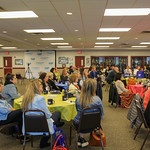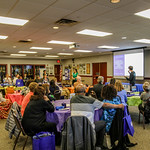|
Back to Success Stories
Riverhead Community Coalition For Safe and Drug-Free Youth
Hosted by:
Riverhead Community Coalition For Safe and Drug-Free Youth

Please briefly describe your Communities Talk activity.
Our coalition held a meet-and-greet event to increase community collaboration. During the event, we had several resource tables for youth and adults. These tables were designed to either help community members understand how their sector connects to the coalition or to educate community members about specific substance use issues, primarily underage drinking, marijuana use, and use of electronic nicotine delivery systems (ENDS). We partnered with the New York National Guard, Peconic Bay Medical Center, Riverhead Police Department, and our coalition members to host the event. A presentation during the event helped to increase attendees’ awareness about the drug trends in the community. Our youth coalition also presented to the attendees and held a call to action to address youth substance use in the community.

How does alcohol and other drug misuse affect your community?

Underage drinking has always been the leading youth substance abuse problem in our community. The most recent Youth Drug Survey (YDS) data from 2022 reveals that 30-day alcohol use rates are high in grades eight, 10, and 12 (2%, 12%, and 24%, respectively). All three are above the national average, with eighth grade rates nearly double the national average of 6%. The same is true for binge drinking rates, with 9.1%, 14.6%, and 27.2% of eighth, 10th, and 12th graders reporting binge drinking in the past two weeks in 2018. In both surveys and interviews, most 10th and 12th graders say alcohol is easy or very easy to get. Most youth report getting alcohol at parties and/or from someone over 21, while most report drinking alcohol in either their own home or the home of a friend, with or without parents’ permission. Other common places youth report drinking are parks and beaches, and public events like fairs and festivals.

Which prevention strategy(ies), as defined by SAMHSA’s Center for Substance Abuse Prevention, best fit your Communities Talk activity?
- Environmental Strategy - focuses on establishing or changing community standards, codes, and attitudes thereby influencing incidence and prevalence of alcohol and other drug use within the community. The strategy depends on engaging a broad base of community partners, focuses on places and specific problems, and emphasizes public policy.
- Community-Based Process Strategy - focuses on enhancing the capacity of the community to address AOD issues through organizing, planning, collaboration, coalition building, and networking.

What goal(s) did you hope to accomplish with your Communities Talk activity?
- Build coalitions with other agencies or programs to reduce and prevent alcohol and/or other drug misuse.
- Limit sales of alcohol at public events where youth are present.
- Draft policy changes for my community that focus on alcohol and/or other drug misuse prevention.
- Work with my local legislators or policymakers to educate about the importance of changes to, or recommend enforcement of, existing laws and policies.

Did you accomplish your goal(s)?
Yes

What challenge(s) did you face in planning your activity this year?
- We were unsure if we would be able to hold the event because of COVID protocols.

How did you overcome these challenges?
We dealt with our challenge of being unsure about whether to bring back the meet-and-greet by having the coalition come to a consensus. Instead of our organization just unilaterally deciding, we brought up the possibility of the meet-and-greet at a coalition meeting. The coalition discussed the possibilities and ultimately decided to hold the event. In order to give the group enough time to plan the event for the first time in years, the group decided to move the event back a month.

What are your next steps?

- Expand our coalition with new partnerships in the community
- Support new prevention policies, legislation, or social ordinances
- Conduct research efforts to learn more about issues in our community

If you’ve conducted Communities Talk activities in prior years, how has your repeated participation contributed to progress in achieving your prevention goals?
The Communities Talk stipend and resources have contributed to our coalition achieving our goals. Our coalition has representation from all 12 sectors, at varying levels of participation. Even so, we are always working to increase our coalition and recruit new members. The Communities Talk stipend allowed us to create an event and invite members of the community that we don’t usually interact with.

Organizations that conduct Communities Talk activities often involve other organizations in the planning and execution of events. Please indicate which type(s) of organizations you involved in your activity planning.
- Law enforcement
- Youth-led organizations
- State and local government agencies (e.g., public health departments)

Which of the following best describes the primary audience(s) for your Communities Talk activity?
- Youth
- Parents
- Teachers or other education staff
- Prevention specialists and volunteers
- Law enforcement officials
- Legislators or policymakers
- Doctors, nurses, or other health care professionals
- Youth leaders (e.g., coaches, parks and recreation personnel, and scouting leaders)
- Healthcare providers
- Clergy
- The media
- Black or African American community members
- Hispanic community members
- Lesbian, gay, bisexual, or transgender (LGBTQ) community members

How did you reach and engage your primary audience(s) to encourage them to participate in your activity?
We engaged our primary audience through personalized letters. We created flyers to advertise the event and stuffed them into envelopes with personalized letters. The letters were sent to superintendents, business owners, coalition members, town board members, town attorneys, local hospitals, and more. We also encouraged attendance by personally reaching out to everyone by email or phone in the days leading up to the event.

Which Communities Talk resources (or other SAMHSA resources) were most helpful for your activity?

- Prevention-related webinars
- Communities Talk website
- Communities Talk toolkits
|
|